Harris C.M., Piersol A.G. Harris Shock and vibration handbook
Подождите немного. Документ загружается.

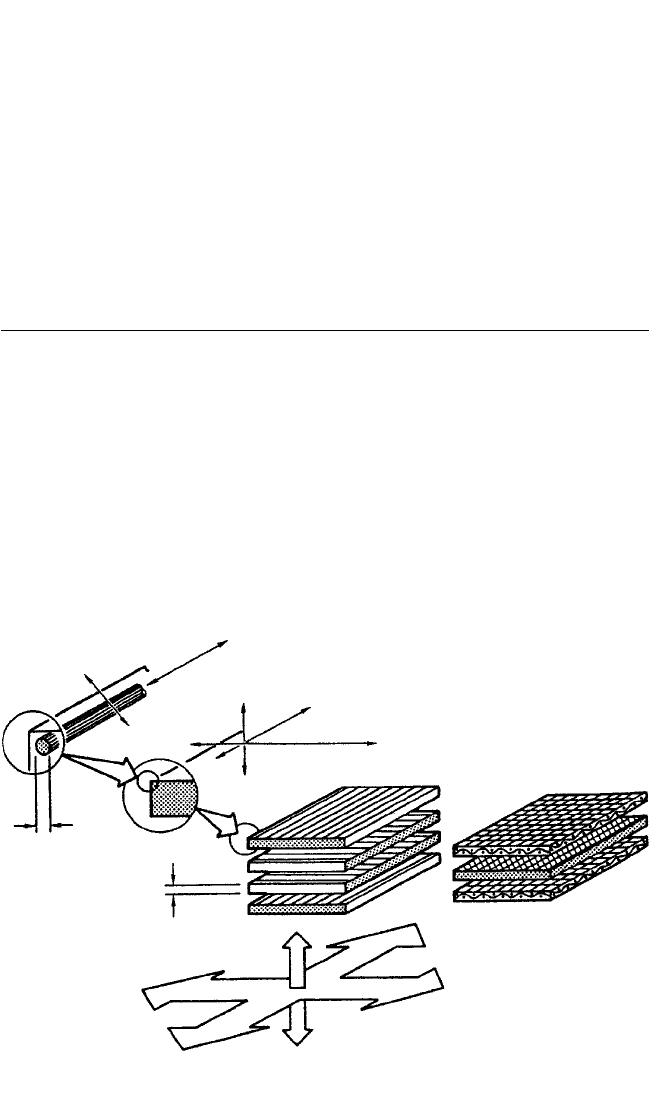
into laminate properties. For all the thermoelastic properties, this translation is
accomplished by the usual rules for transformation of stress and strain. However, the
strength properties tend to be modified by the mutual constraint imposed by adjacent
layers, and therefore is a function of the individual layer thickness.The result is a need
to modify the basic unidirectional properties, one of the most significant being the
ultimate transverse strain to failure in tension of individual layers. Unidirectional
layer compressive strength and the associated ultimate strain to failure is also influ-
enced to a significant degree by the mutual support offered by adjacent transverse or
angled layers.As a consequence, correction factors are sometimes introduced to com-
pensate for these effects, but more routine tests are conducted on the actual laminate
configuration in an effort to establish reliable allowables for its use in design.
LAMINATED COMPOSITE DESIGN
For the simultaneous design of material and structure that is the basic philosophy for
composite structures development, laminated plate theory (LPT) and the associated
computer codes represent the fundamental tool for the composite designer. The
anatomy of a composite laminate indicating the translation from the constituent
fiber and matrix properties to those of a built-up laminate is illustrated in Fig. 35.3.
35.8 CHAPTER THIRTY-FIVE
E
ƒT
= 2 msi (13.8 GPa)
α
ƒT
= 6.0 µε/°F (10.8 µε/°C)
E
ƒL
= 35 msi (241 GPa)
α
ƒL
= –0.5 µε/°F (–0.9 µε/°C)
F
tu
= 400 ksi (2758 MPa)
E
L
= 20 msi (138 GPa)
α
L
= –0.3 µε/°F (–0.54 µε/°C)
F
L
tu
= 240 ksi (1655 MPa)
E
N
= E
T
~
E
T
= 1.4 msi (9.65 GPa)
α
T
= 17.0 µε/°F (30.6 µε/°C)
E
y
= 10 msi (69 GPa)
α
y
= +0.1 µε/°F (0.18 µε/°C)
α
N
> α
T
E
x
= 10 msi (69 GPa)
α
x
= +0.1 µε/°F (0.18 µε/°C)
F
T
tu
= 7 ksi (48.3 MPa)
0.005 in.
(0.0127 cm)
0.0003 in.
(0.00076 cm)
FIGURE 35.3 The anatomy of a composite laminate.
8434_Harris_35_b.qxd 09/20/2001 12:29 PM Page 35.8

Values contained in this figure compare with those presented in Table 35.3. Figure
35.3 also illustrates the use of an alternative form of material, a fabric laminate that
can provide similar, but slightly inferior, properties in a reduced thickness. The abil-
ity to produce a single layer comprised of equal proportions of fibers woven into 0°
and 90° orientations is offered by this approach. Such a textile system therefore rep-
resents a valuable composite form. A state of plane stress and, for bending, plane
sections remain plane, is assumed in most conventional theoretical treatments.
To remain within the scope and purpose of this chapter, the full treatment of
conventional laminated plate theory will not be repeated here since it appears in
numerous established texts on the subject (see Refs. 3 through 8). However, the
essential information on conventional notations, whereby laminates are specified
together with the physical behavioral insights concerning coupling phenomena, will
be presented herein.
LAMINATE CONFIGURATION NOTATION
A method for specifying a given multidirectional laminate configuration has been
established and is now routinely used on engineering drawings and documents. The
following items essentially explain this laminate orientation notation:
1. Each layer or lamina is denoted by the angle representing the orientation (in
degrees) between its fiber orientation and the reference structural axis in the x
direction of the laminate.
2. Individual adjacent angles, if different, are separated by a slash (/).
3. Layers are listed in sequence starting with the first layer laid up, adjacent to the
tool surface.
4. Adjacent layers of the same angle are denoted by a numerical subscript.
5. The total laminate is contained between square brackets with a subscript indicat-
ing that it is the total laminate (subscript T) or one-half of a symmetric laminate
(subscript S).
6. Positive angles are assumed clockwise looking toward the lay-up tool surface, and
adjacent layers of equal and opposite signs are specified with + or − signs as
appropriate.
7. Symmetrical laminates with an odd number of layers are denoted as symmetric
laminates with an even number of plies, but with the center layer overlined.
The notations for some commonly used laminate configurations are illustrated in
Fig. 35.4.
In essence, lamination theory is involved in the transformation of the individual
stiffnesses of each layer in the principal directions to the direction of orientation in
the laminate, thereby providing the stiffness characterization for the specified lami-
nate configuration. Subsequently, application of a given system of loads is broken
down into individual layer contributions and referred back to the principal direc-
tions in each layer.A failure criterion is then used to assess the margin-of-safety aris-
ing in each layer.The complete process is illustrated in Fig. 35.5.
FAILURE CRITERIA
Although much debate and development has occurred with regard to the most
appropriate failure criteria for composite laminates, the most widely adopted
ENGINEERING PROPERTIES OF COMPOSITES 35.9
8434_Harris_35_b.qxd 09/20/2001 12:29 PM Page 35.9

35.10 CHAPTER THIRTY-FIVE
FIGURE 35.4 Examples of laminates and conventional notations.
8434_Harris_35_b.qxd 09/20/2001 12:29 PM Page 35.10
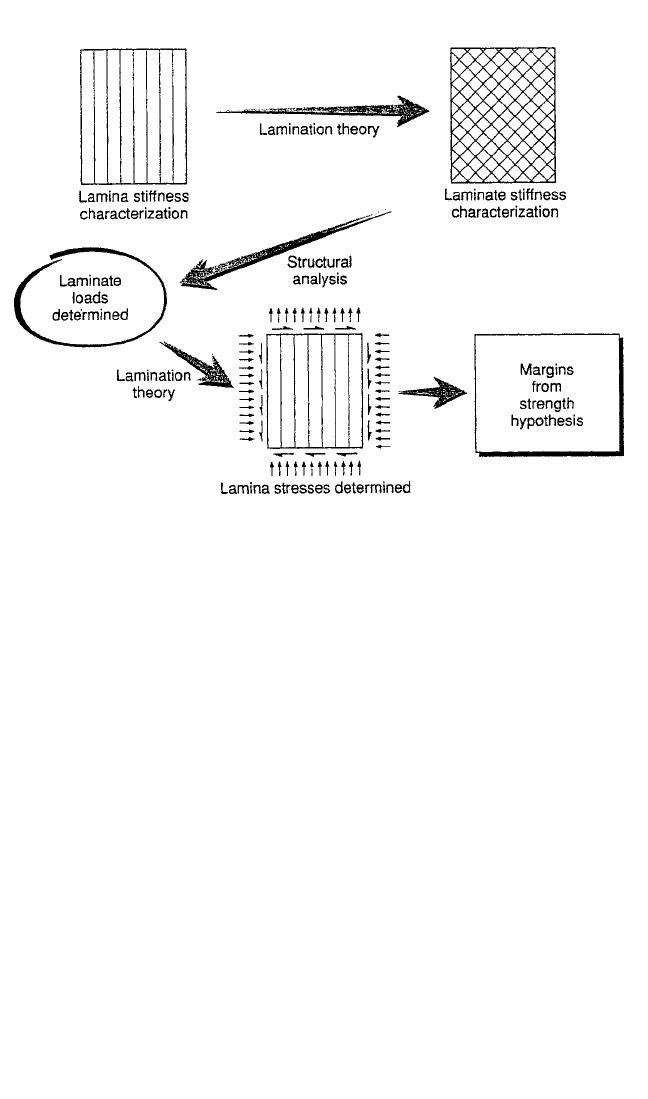
approach in composite applications is the maximum strain criterion. The application
of this relatively simple criterion requires an experimental database for the ultimate
strains for each of the three fundamental loading directions for the individual
orthotropic layer comprising the laminate.The three fundamental loading directions
refer to axial loading in the fiber direction, axial loading transverse to the fiber direc-
tion, and in-plane shear associated with the former directions. However, it should be
acknowledged that the ultimate strain values may be markedly different for tension
and compression both in the fiber direction and transverse to it. Thus a total of the
following five ultimate strains are required to facilitate application of the maximum
strain criterion:
1. ε
L
tu
is the ultimate tensile strain in the fiber direction.
2. ε
L
cu
is the ultimate compressive strain in the fiber direction.
3. ε
T
tu
is the ultimate tensile strain transverse to the fiber direction.
4. ε
T
cu
is the ultimate compressive strain transverse to the fiber direction.
5. γ
su
LT
is the ultimate shear strain associated with directions parallel and normal to
the fiber direction.
In connection with the actual values used for (1) through (5), see the previous dis-
cussion on In-Situ Properties, which explains how the individual layer properties
must be adjusted to represent the strength or ultimate strain values of a given layer
that is contained within a multidirectional laminate. The prudent approach in engi-
neering development work is to identify special laminate configurations that may be
used to establish representative “in situ” properties for the range of potential candi-
date laminates for application to a specific design.
ENGINEERING PROPERTIES OF COMPOSITES 35.11
FIGURE 35.5 Procedure for strength determination.
8434_Harris_35_b.qxd 09/20/2001 12:29 PM Page 35.11

COUPLING, BALANCE, AND SYMMETRY
The mathematical relationships obtained in laminated plate theory define all the
coupling relationships arising in the arbitrary laminate. However, a discussion of the
physical aspects of such coupling phenomena and the laminate designs that may be
invoked to suppress these responses is helpful to the structural engineer.
Extension-Shear Coupling. First, the in-plane coupling between extension and
shear or vice versa arises in the case of any off-axis layer, for example,
γ
xy
= S
16
σ
x
or ε
x
= S
16
τ
xy
(35.1)
or, for the inverse situation,
σ
x
= Q
16
γ
xy
or τ
xy
= Q
16
ε
x
(35.2)
where S
16
and Q
16
are, respectively, the compliance and stiffness terms defining the
coupling magnitudes.
3
From a physical point of view, the shear deformation induced
by an axial tensile stress is caused by the tendency for the layer to contract along the
diagonals by unequal amounts due to differences in the Poisson’s ratio in these two
directions. Alternatively, considering the special case of a +45° layer, the axial stress
may be resolved into planes at +45° and −45° to the direction of applied stress. The
resulting strains due to equal resolved stress components along these directions are
obviously different.
Intuitively, it is easily rationalized that the use of a [±θ]
T
laminate will result in the
mutual suppression of the tension-induced shear deformation in each individual
layer. In the general case, equal numbers of layers in the off-axis, +θ and −θ, layers
will suppress this coupling; the resulting laminate is termed a balanced laminate.
Extension-Torsion Coupling. For this the previous balanced laminate [±θ]
T
is
considered. The spatial separation in the thickness direction results in equal and
opposite deformations in the shear deformation induced by an axial tensile stress.
This deformation situation therefore results in twisting of the laminate, a condition
that is illustrated in Fig. 35.6. From a simplistic viewpoint, the illustration presented
in Fig. 35.7 provides a type of designers’ guide to coupling evaluations, which facili-
tates rational judgments in laminate design.All the responses indicated in these two
figures can be confirmed by use of conventional lamination theory. Suppression of
the twisting deformation is achieved by use of a symmetric laminate in which the off-
axis layers below the central plane are mirrored by an identical off-axis layer at the
same distance above the central plane (see Fig. 35.7).
Extension-Bending Coupling (Related through B
11
and B
22
Matrix Compo-
nents). The simplest form of laminate, exhibiting a coupling between in-plane
extension (or compression) and bending deformation, is the [0°,90°]
T
unsymmetri-
cal laminate. This response can be rationalized, on a physical basis, by recognizing
that the neutral plane for this two-layer laminate will be located within the stiffest 0°
layer, giving rise to a bending moment produced by the in-plane forces applied at the
midplane and the associated effect between the two planes. For this case, it is clearly
seen that the coupling would be suppressed by use of a four-layer symmetric lami-
nate, i.e., [0°,90°]
s
, or a three-layer symmetric laminate such as [0°,9
0
°]
s
, where the
bar over the 90° layers signifies that this layer orientation is not repeated.
35.12 CHAPTER THIRTY-FIVE
8434_Harris_35_b.qxd 09/20/2001 12:29 PM Page 35.12
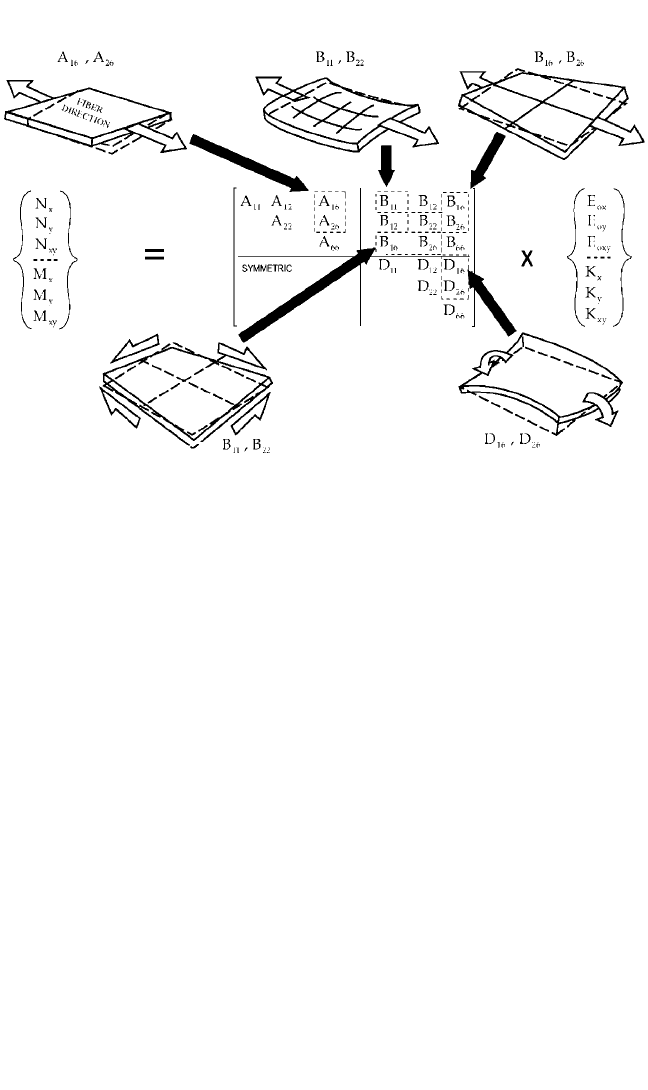
In-Plane Shear-Bending Coupling (Related through B
16
and B
26
Matrix Com-
ponents). To visualize the mechanism associated with this mode of coupling, con-
sider a [±45°]
T
unsymmetrical, two-layer laminate subjected to in-plane shear loads.
By recognizing that the in-plane shear is equivalent to a biaxial tension and com-
pression loading with the tensile direction in the lower layer aligned with the fiber
direction and, in the upper layer, transverse to the fiber direction, it will be realized
that the plate will assume a torsional deformation (see Fig. 35.6).
Bending-Torsion Coupling (Related through D
16
and D
26
Matrix Components).
For this mode of coupling, a four-layer balanced symmetric laminate, i.e., [±θ]
s
,is
considered.The application of a bending moment, and an associated strain gradient,
to this laminate will induce different degrees of shear coupling to the outer and
inner layers.As a consequence, the response of the outer layers will dominate due to
the higher strain levels in these layers, resulting in a net torsional deformation, as
illustrated in Fig. 35.6. For qualitative assessment of this mode of coupling, the mag-
nitude of the shear responses can be considered to exert an internal couple on the
laminated plate as illustrated in Fig. 35.7. A similar rationale can be used to design a
laminate that would not exhibit this coupling. For example, an eight-layer laminate
of the configuration
[(θ)
s
/(θ
s
)]
T
or [θ, θ, θ, θ]
T
will not exhibit bending-torsion coupling.
ENGINEERING PROPERTIES OF COMPOSITES 35.13
FIGURE 35.6 Illustration of coupling phenomena in laminated composite plates.
8434_Harris_35_b.qxd 09/20/2001 12:29 PM Page 35.13
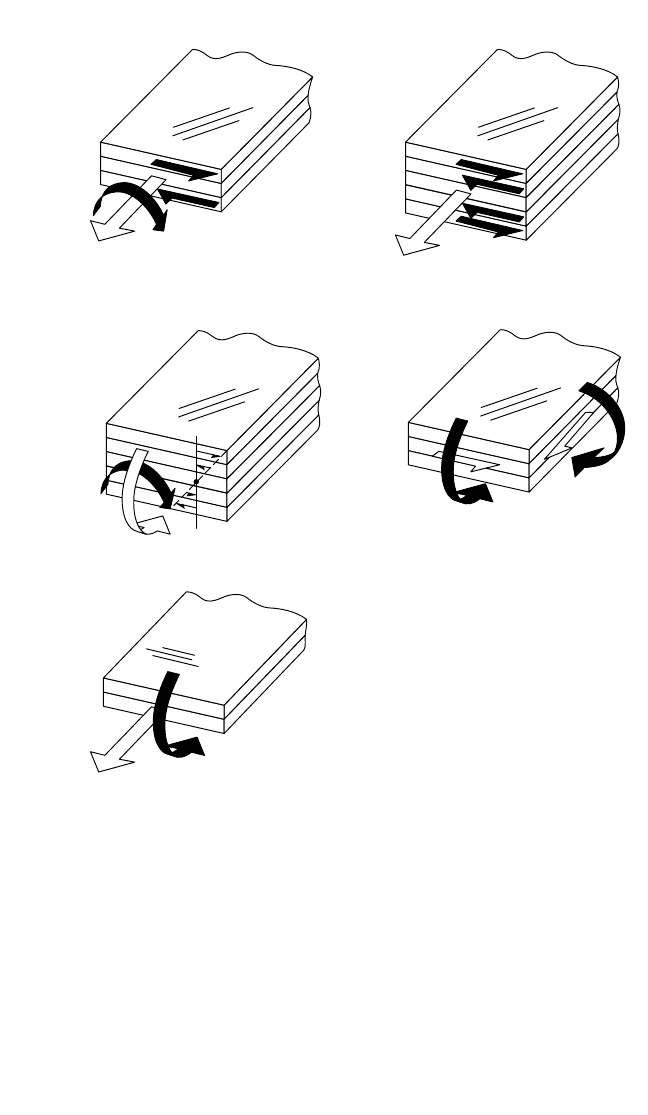
GENERAL LAMINATE DESIGN PHILOSOPHY
The recommended approach for laminates that are required to support biaxial loads
is conveyed in the family of laminates represented by the shaded area in Fig. 35.8.
This figure merely provides guidelines for selecting suitable laminates that have
been shown to be durable and damage-tolerant. However, the form of presentation
is also adopted for a system of carpet plots that can be very useful in the design and
analysis of laminates for a specific composite system. These carpet plots facilitate
reasonable predictions of the elastic and strength properties, and the coefficients of
thermal expansion for a family of practicable laminates that comprise 0°, +45°, and
35.14 CHAPTER THIRTY-FIVE
+θ
–θ
0°
–θ
+θ
(a)
(c)
(e)
(b)
N
x
+θ
–θ
0°
–θ
+θ
M
x
N
x
+θ
0°
–θ
(d)
N
xy
+θ
0°
–θ
0°
90°
N
x
FIGURE 35.7 Designer’s guide to coupling evaluation. (a) B
16
≠ 0. (b) B
16
= 0. (c) D
16
≠ 0.
(d) B
16
, B
26
≠ 0. (e) B
11
, B
22
≠ 0. Open arrows: applied force/moment. Shaded arrows: resulting
displacement.
(a)
(b)
(c)
(d)
(e)
8434_Harris_35_b.qxd 09/20/2001 12:29 PM Page 35.14
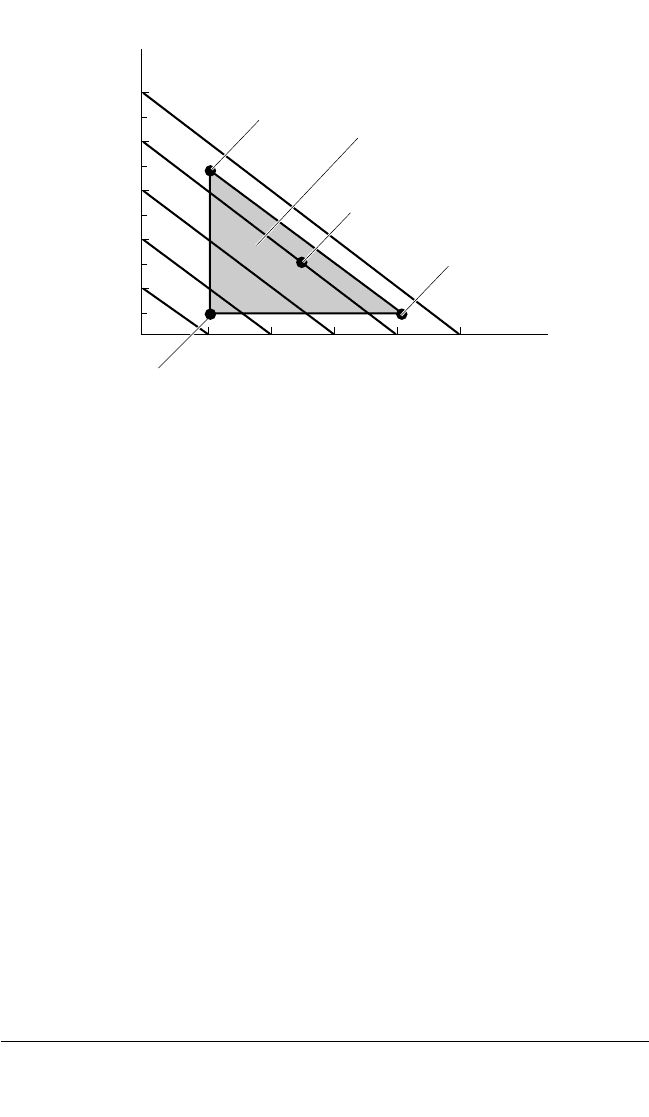
90° fiber orientations of any proportions in an assumed balanced, symmetric lami-
nate arrangement. Examples of these carpet plots are presented in Ref. 3 and in
most of the texts referenced previously. Even for highly directional loading, a nomi-
nal (approx. 10 percent) amount of layers, in each of the 0°,90°, +45°, and −45° direc-
tions, should be included for the following reasons:
1. Providing restraints that inhibit development of microcracks that typically form
in directions parallel to fibers.
2. Improved resistance to handling loads and enhanced damage tolerance (this is
especially relevant for relatively thin laminates, i.e., less than 0.200 in. thick).
3. More manageable values of the major Poisson’s ratio (v
xy
), particularly where
interfaces exist with other materials or laminates with values in the 0.30 range.
4. Compatibility between the thermal expansion coefficients with respect to adja-
cent structure.
Other commonly adopted and recommended practices include laminate designs that
minimize the subtended angle between adjacent layers and use of the minimum prac-
ticable number of layers of the same orientation in one group. To illustrate the for-
mer, a laminate configuration of [0°, +45°,0°, −45°,90°]
s
is preferred over a laminate
such as [0°, +45°, −45°,0°,90°]
s
even though the in-plane thermoelastic properties
would be identical for these two laminates. For the latter, the length of transverse
microcracks tends to be limited by the existence of the layer boundaries; hence a [0°,
+45°,0°, −45°,0°,9
0
°]
s
laminate is preferred over a [0°
3
, +45°, −45°,9
0
°]
s
laminate.
FATIGUE PERFORMANCE
The treatment of fatigue and damage accumulation in composite design is greatly
complicated by the heterogeneity and anisotropy of the material in the laminated
ENGINEERING PROPERTIES OF COMPOSITES 35.15
100%
PERCENT 0° LAYERS
80%
60%
40%
20%
20% 40% 60% 80% 100%
PERCENT ±45° LAYERS
10% 0°
20% ±45°
70% 90°
70% 0°
20% ±45°
10% 90°
ISOTROPIC POINT
25% 0°
50% ±45°
25% 90°
RANGE OF RECOMMENDED
LAMINATE CONFIGURATION
10% 0°
80% ±45°
10% 90°
FIGURE 35.8 General guidelines for the selection of durable, damage-
tolerant laminate design.
8434_Harris_35_b.qxd 09/20/2001 12:29 PM Page 35.15

form. As a consequence, there is a multiplicity of mechanisms for the initiation and
propagation of damage and, understandably, the approaches, such as Miner’s cumu-
lative damage rule discussed in Chap. 34, are not recommended. For similar reasons
the test results obtained from small laboratory test coupons can rarely be used
directly in support of design for prediction of fatigue performance. Nevertheless,
such test coupon data can serve the purpose of obtaining preliminary indications of
the fatigue performance of specific laminate design configurations.
Basic failure mechanisms that occur in laminated composites, in general, include
the following:
1. Transverse cracking of individual layers in multidirectional laminates which will
typically arrest at the interlaminar boundaries.
2. Fiber-matrix debonding which often can contribute to premature transverse
cracking.
3. Delamination between layers due to interlaminar shear and/or tensile stress com-
ponents that can be initiated by the aforementioned transverse cracks. Out-of-
plane or bending loads on the structure will tend to give rise to such delamination.
4. Fiber breakage which will usually occur in the later stages of damage growth
under monotonic static loading or under cyclic loading. However, most reinforc-
ing fibers are not, in themselves, fatigue sensitive.
The first two initiating mechanisms motivate the above general laminate design phi-
losophy advocated in the previous section, as illustrated in Fig. 35.8. A common
sequence of failure events is illustrated for a quasi-isotropic, [±45°,0°,90°]
s
, car-
bon/epoxy laminate, also summarized in Fig. 35.9 (adapted from Ref. 9).
It may be stated, with some confidence, that the composites industry is able to
design polymer matrix composite (PMC) laminates of uniform thickness in a reli-
able manner. Extensive experience with PMCs has taught us to use fiber-dominated
laminate designs, which are most often specified in the [0°/±45°/90°]
s
or pseudo-
isotropic form with respect to the in-plane directions. In-plane compression failure
is somewhat of an exception since the matrix and the degradation thereof can
develop delaminations and influence premature failure mechanisms. However, by
far the largest number of development and in-service problems with composite
hardware are associated with matrix-dominated phenomena, that is, interlaminar
shear and out-of-plane tension forces. This is a major concern in that failure con-
tributed by either one or a combination of these matrix-dominated phenomena are
susceptible to the following:
1. High variability contributed by sensitivity to processing and environmental con-
ditions.
2. Brittle behavior, particularly for early, i.e., 1970s era, epoxy matrix systems.
3. Inspectability of local details where flaws or defects may exist.
4. Low reliability associated with the lack of acceptable or representative test meth-
ods and complex, highly localized, stress states (the use of the transverse tensile
strength of a unidirectional laminate for out-of-plane or thickness tensile
strength is generally unconservative).
5. Potential degradation of residual static strength after fatigue/cyclic load exposure.
The development of stress components that induce interlaminar shear/out-of-
plane tension failures was illustrated in Fig. 35.2, where commonplace generic fea-
tures of composite hardware designs that frequently experience delaminations are
35.16 CHAPTER THIRTY-FIVE
8434_Harris_35_b.qxd 09/20/2001 12:29 PM Page 35.16
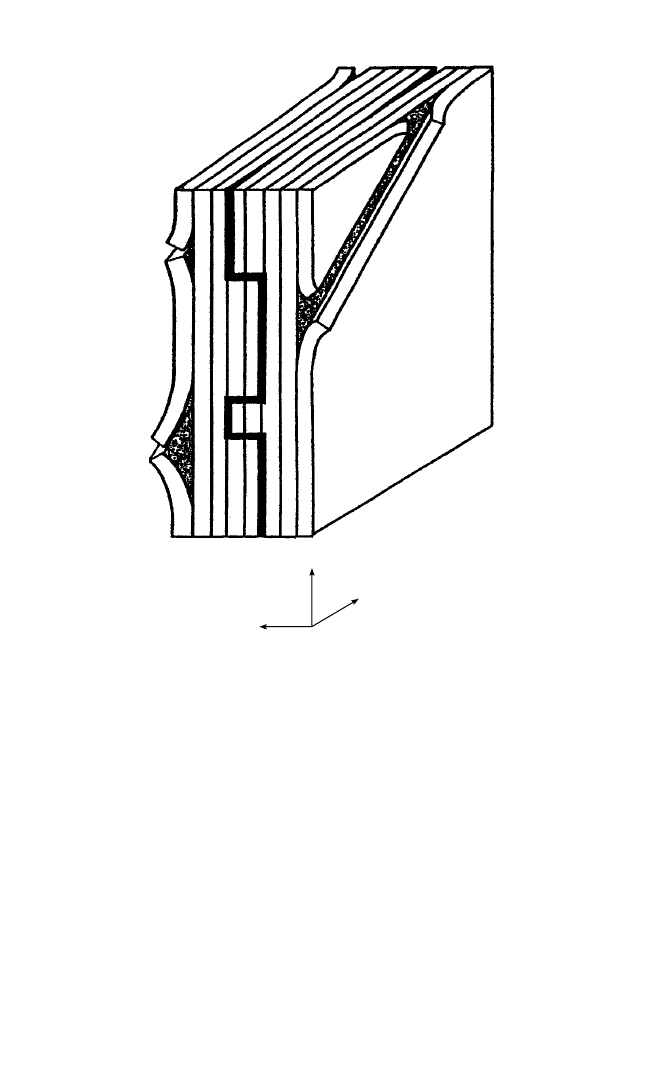
shown. It is at such details that PMC structures are particularly vulnerable both under
static and fatigue loading. The propensity for delamination and localized matrix-
dominated failures that represents a general characteristic of many PMCs is that
notch sensitivity may be reduced after fatigue load cycling for local through-thickness
penetrations. On the other hand, this demands that a fatigue life methodology should
be available to deal with composite structures that are subjected to out-of-plane load
components. Naturally, the capability of predicting the fatigue life is an essential ele-
ment in the process of qualifying, or certifying, composite products and systems.
The design requirements generally specified for qualifying and/or certifying a
composite product typically include (a) static strength, (b) fatigue/durability, and (c)
damage tolerance. All of these requirements rely on a comprehensive appreciation
of failure modes; the variability (or scatter); discontinuities caused by notches, holes,
and fasteners; and environmental factors, particularly damage caused by the impact
of foreign objects, machining, and assembly phenomena.
ENGINEERING PROPERTIES OF COMPOSITES 35.17
++
x
y
z
––
90 90
00
++–
90 90
00
FIGURE 35.9 A common sequence of fatigue failure
events for a [±45/0/90]
s
pseudo-isotropic carbon/epoxy
laminate: transverse cracking of 90° plies; edge de-
lamination at 0°→90° interfaces; transverse cracking
of ±45° plies; delaminations at 45°→+45° then at
45°→0° interfaces; fiber failures in 0° plies. (Adapted
from Ref. 9.)
8434_Harris_35_b.qxd 09/20/2001 12:29 PM Page 35.17
